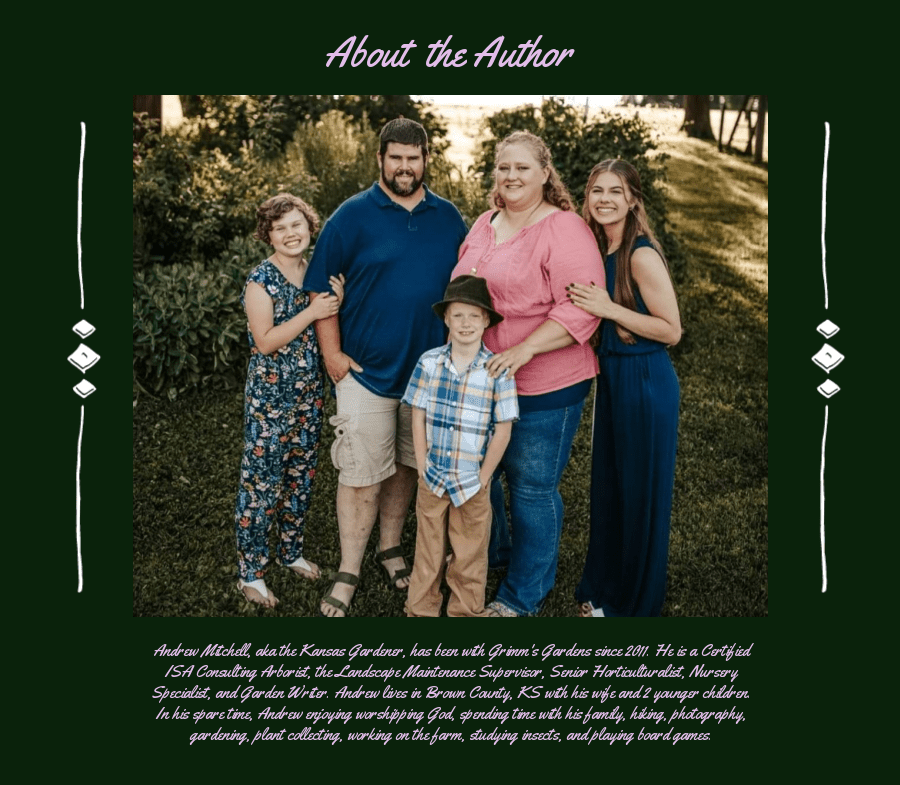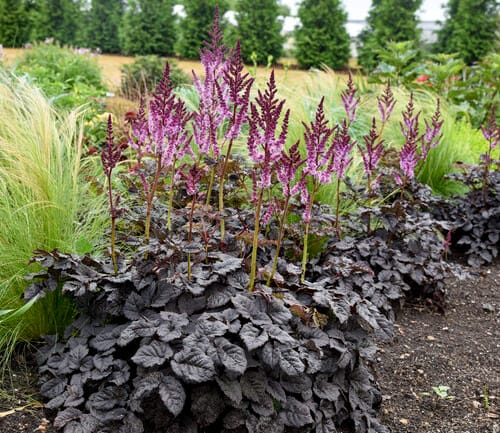Putting dark leaves in the garden not only adds depth, but also intrigue, and if done right, mystery. Plants with dark leaves are rare in nature, but abound in the nursery trade, after being bred and selected for generations. I love using dark leaves in the garden, more so than chartreuse or variegated leaves. But how do we add them to the garden? What kind of plants do you find them on? And are they still beneficial to insects in the garden?
Why do some plants have dark leaves? The red and purple hues in the leaves of some plants is caused by the leaf containing more anthocyanin than chlorophyll. Chlorophyll absorbs red and blue light wavelengths, but not green, which is why most plants appear green to the human eye. Plants with higher concentrations of anthocyanins, appear red or purple, because they absorb green light, and not red or blue.
Plants with dark leaves also have less damage from insects and herbivores, overall. While they do still get eaten by some insects; they have a higher build-up of poisonous phenols (such as tannins), which makes them less attractive to deer and rabbits.
No matter why or how dark leaves come about, plants with them are attractive and desirable in the landscape.
Trees with Dark Leaves
Despite rarely being found in nature, trees with dark leaves are quite common. If you go to any older city, especially in the Central Great Plains or the Midwest, you will find lots of dark leaved trees. In the 1950s, many starts of the well-known ‘Crimson King’ maple were planted throughout the U.S. These medium shade trees were quite popular. And the dark, purple leaves made it eye-catching in the landscape.
Besides ‘Crimson King’, there are a number of ornamental and shade trees which have reddish or purple leaves. A variety of maples, crabapple, cherry, plum, birch, redbud, and beech all have dark leaves.
Maples
There are a lot of maples which have more anthocyanins than chlorophyll. But to keep this post from getting too long, I will just go over some of the best for the Central Great Plains. Here, we can grow sugar, Norway, silver, Freeman hybrid, some Japanese, and others quite easily. However, most of the Japanese maples are not hardy here.
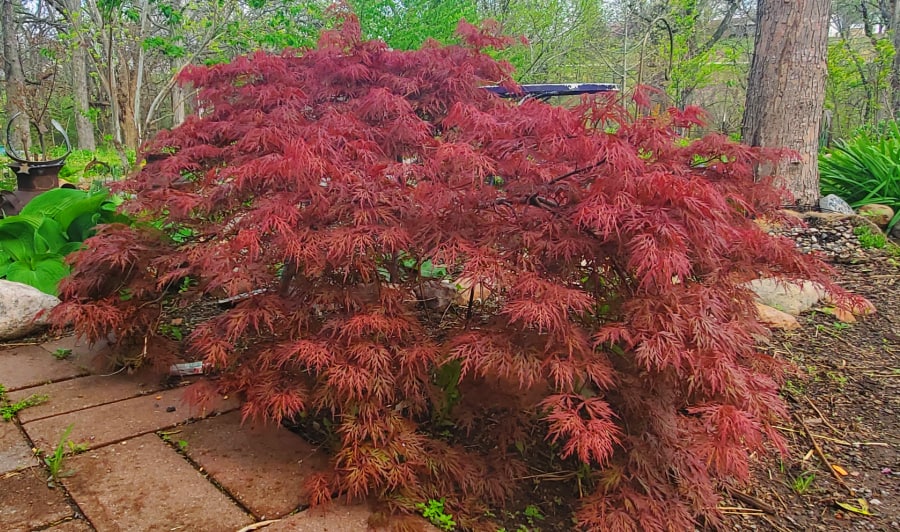
Japanese Maples
- ‘Bloodgood’ is one of the best known and easiest to find (usually) in the nursery trade. It is also the most cold hardy, growing in the northern parts of the Central Great Plains. It grows 30 feet tall and wide. Leaves are dark purple.
- ‘Orangelo’ is my favorite cultivar. It has deeply cut leaves, a dark reddish color in spring and summer. While it grows 10 to 15 feet tall by 6 to 10 feet wide, I bent my sideways to appear more weeping than the average specimen.
- ‘Tamukeyama’ is a weeping form with deep purple-red leaves. It grows 10 feet tall and wide.
Other Maples with Dark Leaves
- ‘Crimson King’ is a Norway maples and grows 30 to 50 feet tall and wide. This is the old standard for purple leaves.
- ‘Crimson Sunset’ is a cultivar of Acer truncatum, and is more sun and heat tolerant than ‘Crimson King’. It grows 35 feet tall and wide, possible bigger.
Crabapples
Crabapples are probably overused in most landscapes, but they do fit into spaces where many other trees do not. Most crabs do not get bigger than 25 feet tall and wide, and there are lots which are dwarf in size. And, if you have one in your landscape, you do not need a pollinator for apple trees.
- ‘Prairie Fire’ is one of the most popular crabapples for the Central Great Plains, if not the whole country. With dark purple leaves that hold up well in sun, and purple-pink flowers, it is really a nice plant. It grows 20 feet tall and wide.
- ‘Royal Raindrops’ – has very dark leaves, and is a more cutleaf form than others. It grows 20 feet tall and wide, with pink flowers and bright red fruit.
- ‘Raspberry Spear’ is a nice upright tree, with purple foliage and magenta flowers. It grows 20 feet tall by 8 feet wide. I think it would make an excellent hedge or screen if planted densely and lower branches left on.
Redbuds with Dark Leaves
One of my favorite small trees, redbuds are glorious in early spring with their pink, purple, or white flowers. When my ‘Prairie Fire’ crabapple blew down in a storm in 2021, I replaced it with a purple leafed redbud, ‘Forest Pansy’.
- ‘Forest Pansy’ is an old standard, though sometimes it turns green with too much heat or sun. Plant it in shade to prevent this. Considered hardy to Zone 6, it grows well in my 5b garden. It grows 20 feet tall and wide.
- ‘Burgundy Hearts’ has deeper maroon foliage, and is more sun tolerant than ‘Forest Pansy’. It grows 20 feet tall and 15 feet wide.
- ‘Ruby Falls’ is a weeping form, growing 6 to 8 feet tall and 5 feet wide, depending on where the graft union is placed. I observed a nice specimen at the Southeast Nebraska Cancer Garden in Humboldt, NE, which was maroon in full sun in late summer of 2022.
Beech
While it is not extensively grown in the Central Great Plains, beech trees can be found here. Whether the American (Fagus grandiflora) or European (Fagus sylvatica), there are a number of great specimens. Purple leaves cultivars of European beech are the most common.
- ‘Purple Fountain’ grows 30 feet tall by 15 feet wide with deep purple leaves.
- ‘Rivers Purple’ is the deepest purple form, nearly black in color. It grows 40 to 50 feet tall and wide.
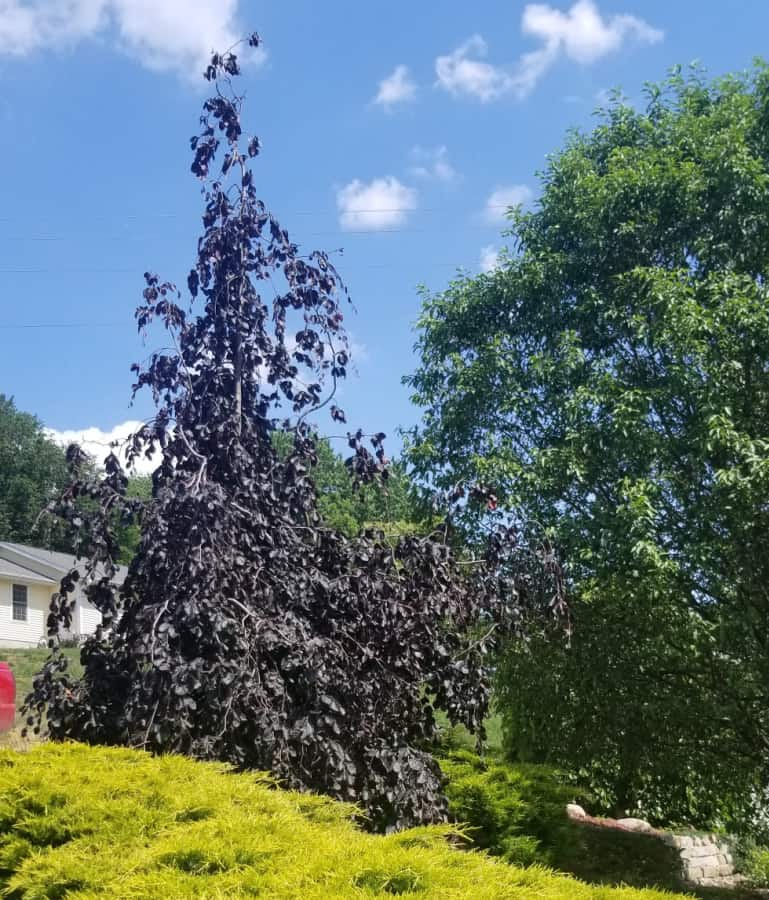
Cherries and Plums
There are a variety of cherries and plums with dark leaves or purple foliage. But, there are not very resistant to black knot, which is the most common disease of plums, and can often ruin a large specimen if not pruned out bi-yearly.
- ‘Thundercloud’ is a nice cultivar, growing 30 feet tall and wide. It is possibly the most disease-resistant of all plums.
- ‘Royal Burgundy’ is a nice dark purple foliage cherry with bright pink flowers. It grows 30 feet tall and wide.
- ‘Canada Red Select’ is a common selection of our native chokecherry. The purple leaves hold their color even in full sun, though it is susceptible to black knot.
Other Trees with Dark Leaves
The above lists are mainly recommendations for the Central Great Plains, not an extensive list. There are a couple other trees which have dark leaves and which I would recommend for landscape use.
- Birch ‘Royal Frost’ a cross between river birch and white birch, this variety is one of my favorite trees. It have bright white bark offset by deep purple leaves. Fall color is orange to red.
- Mimosa ‘Summer Chocolate’ is a beautiful small tree, very tropical looking. Hardy in Zone 6 and up, it does not grow best in northern parts of the Central Great Plains.
Dark Leaved Shrubs
The really fast way to add dark leaves to the garden is with shrubs. There is an exciting number of shrub variety to use in the garden, and dark leafed plants are very easy to find. I have a variety of shrubs in a border along the edge of my driveway, and using ones with purple or maroon leaves helps the whole border stand out in spring and summer. Shrubs can be used for many things, from screens to hedges, and from focal points to backdrops.
Native Shrubs with Dark Leaves
While these shrubs are not true natives, but rather highly bred cultivars of North American native plants, they are still beneficial to our native birds and insects. There is a large variety and I will focus mainly on the ones I love best for the landscapes in the Central Great Plains.
- Ninebark ‘Little Devil’ – though I am not fond of the name, I love this variety which has small leaves, pink flowers, and a vase shaped habit, growing 3 to 5 feet tall and wide.
- Ninebark ‘Coppertina’ – with dark, amber colored leaves, it is a most interesting color than purple. New foliage is almost orange, and the plant grows 5 to 8 feet tall and wide.
- Diervilla ‘Kodiak Black’ – one of my favorite shrubs for hummingbirds, this plant has dark purple leaves and bright yellow flowers. It grows about 4 feet tall and may spread from 5 to 8 feet.
- Ninebark ‘Amber Jubilee’ – my favorite ninebark, it has amber colored new growth above bronzy-red leaves. It grows 7 feet tall by 4 feet wide, a more upright shrub.
- Elderberry ‘Black Lace’ – while it does turn green in strong light, it does hold color well when in part shade. I love the lacy foliage, which works well for a textural difference. It grows 8 feet tall and wide.
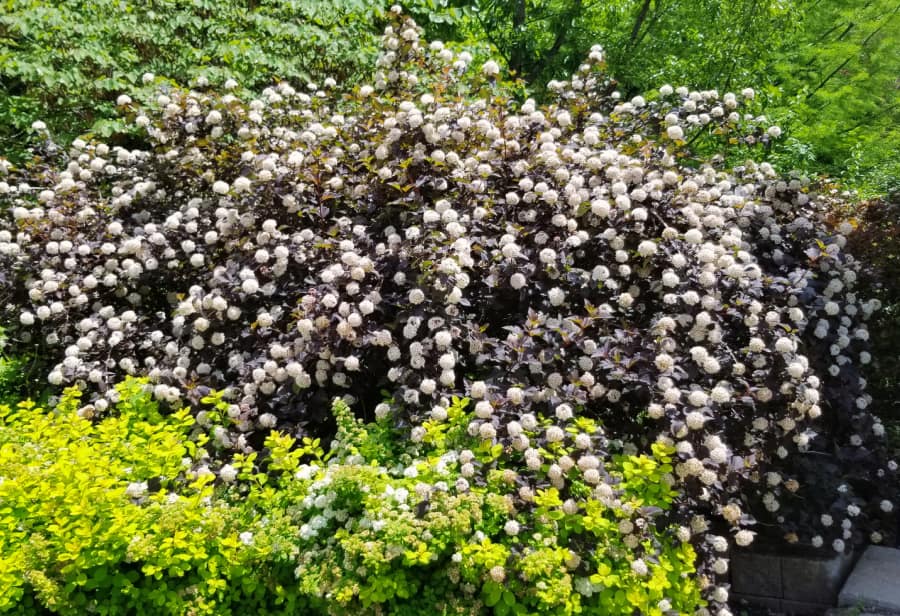
Nonnative Shrubs
Before I dive into the various dark leafed shrubs that are nonnative, I must say that I do not recommend barberry as a dark leafed plant. While there are many cultivars available, the thorns and invasiveness of the plant put me off. Why plant a barberry with thorns when we have a range of ninebarks without?
- Weigela ‘Wine and Roses’ – one of the first shrubs I used as a designer out of college for part shade, I love the various weigelas. This one grows 6 to 8 feet tall and wide, with dark purple leaves and red flowers.
- Crape Myrtle ‘Center Stage Series’ – though not hardy north of Zone 6, most of the southern parts of the Central Great Plains can grow these dark leafed shrubs.
- Filbert ‘Purpurea’ – filberts are great additions to the edible landscape, and this one boast purple leaves and purple tinted fruiting husks around an edible nut. It grows 25 feet tall and 10 feet wide.
- Weigela ‘Wine and Spirits’ – a newer version of my favorite weigela with white flowers instead of red. It grows 5 feet tall and wide.
- Smokebush ‘Winecraft Black’ – I must say that I have a dark leaved smokebush in my Entry Garden, and it really helps tie the space together. This one is an improvement over older varieties, whose color is not as strong in sun. It grows 10 feet tall and wide.

Perennials with Dark Leaves
The best way to use perennials with dark leaves is to mass them in plantings. 3 or more plants in a grouping can really add depth to the garden, especially when the plants have dark colored leaves.
Natives with Dark Colored Cultivars
- Penstemon ‘Onyx and Pearls’ – I ordered this one before we sold it in the garden center, and I have been totally impressed with the dark leaves and white flowers in mid-spring. In the heat of summer, it shines among green-leafed plants in my Sunny Cottage Garden.
- Foamflower ‘Hopscotch’ – a new variety from Proven Winners, this shade loving perennials has reddish leaves and foamy white flowers.
- Hardy hibiscus ‘Holy Grail’ – one of the darkest leafed perennials I have ever seen. Coupled with scarlet red flowers, it is a hummingbird magnet in the sunny garden.
- Coral bells ‘Grape Expectations’ – has nearly pure purple leaves with slight silvery veining. A must have for shade.
- Black Cohosh ‘Hillside Black Beauty’ – another plant for the shade garden, it has deeply cut, fern-like foliage which is dark purple-black. Flowers are white with a pink cast.
- Hardy hibiscus ‘Starry Starry Night’ – who does not love the reference to Gogh’s Starry Night? Anyways, this hibiscus feature almost black leaves and pink flowers with red radians.
- Lobelia ‘Starship Scarlet Bronze Leaf’ – a native wetlands plant with dark leaves and scarlet flowers? Yes, please. Despite a love for water, this lobelia is marginally drought tolerant.
- Big bluestem ‘Blackhawks’ – the only grass on my list, this nativar of big bluestem lights up in the meadow garden. The leaves and flower stalks are purplish-black and very upright.
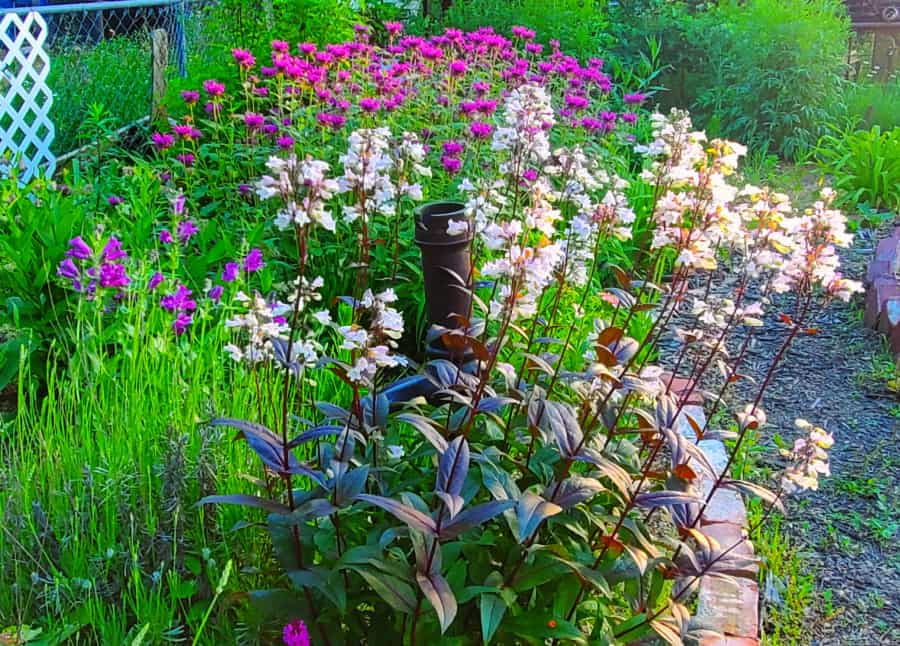
Nonnative Perennials
- Astilbe ‘Dark Side of the Moon’ – a new cultivar from Proven Winners, I expect this one to do well in our region. While most astilbe goes dormant in our hot summer heat, they still give a good floral display in spring. This one is supposed to be more sun tolerant and has deeply purple leaves and dark pink flowers.
- Ligularia ‘Britt Marie Crawford’ – I have been adding ligularia to my shade garden in the last few years, because I love the large foliage and bright yellow flowers. Add in the dark leaves of this variety and you have the full package for the shade.
- Sedum ‘Back in Black’ – has dark, thick leaves and reddish-pink flowers. It works great in rock gardens or full sun with lots of heat. Sedums are a must-have for late season pollinators.
- Sedum ‘Night Embers’ – I fell in love with dark leaved sedums with this one. It has richly dark leaves with maroon flowers on upright stems. In my Sunny Cottage Garden Daylily Bed, it does duty with other similar sedums.
Uses of Dark Leaves in the Garden
If you are trying to build a pollinator garden or insect-driven garden, you may want to shy away from too many dark leafed plants. While they are nice additions to any garden, they increased tannins and anthocyanins in the leaves are deterrent to many insects. The native cultivars will provide some food source for insects, but usually only for specialists, and not generalist feeders.
In the garden itself, plants with dark leaves can be added to added depth and mystery to the garden. Put some in a grouping where there are too many green leafed plants and watch the space transform into a room. Or you can highlight well-placed purple leafed tree, by making is a focal point in the garden, with paths leading to it. There are many ways in which to add or use these plants in the garden.
In the shade garden, for example, adding dark leaved plants may seem counter-productive, but they can add depth which develops the space. Add some contrasting chartreuse leaves plants next to them for even more depth.
Conclusion
Plants with dark leaves can certainly add depth and mystery to the garden. Besides this, they are a unique kind of plants, rare in nature, but beautiful. Add some into the various parts of your gardens to draw you and your visitors more deeply into the wonder of gardening.
Happy planting!
